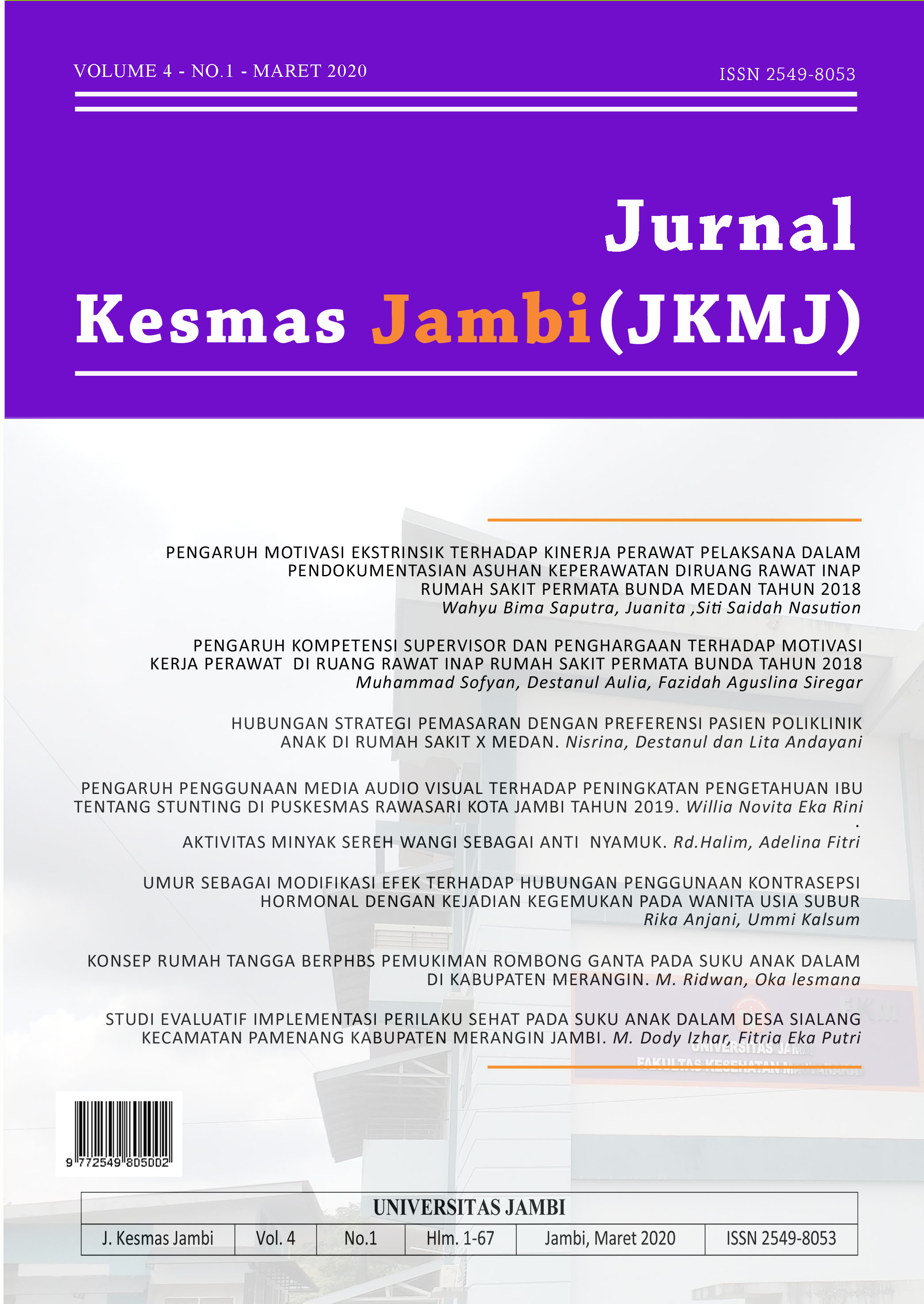Aktivitas Minyak Sereh Wangi Sebagai Anti Nyamuk
DOI:
https://doi.org/10.22437/jkmj.v4i1.8940Abstract
Indonesia sebagai salah satu negara tropis di dunia dengan kelembaban udara yang cukup tinggi menjadi pemicu berkembang biaknya nyamuk seperti Aedes aegypti yang merupakan salah satu vektor DBD, Pada tahun 2017 jumlah penderita DBD di Indonesia yang dilaporkan sebanyak 129.650 kasus dengan jumlah kematian sebanyak 1.071 orang (IR/Angka kesakitan= 50,75 per 100.000 penduduk dan CFR/angka kematian= 0,83%). Dibandingkan tahun 2016 dengan kasus sebanyak 100.347 serta IR 39,80 terjadi peningkatan kasus pada tahun 2015. tanaman serai wangi menghasilkan minyak atsiri yang dikenal sebagai Citronella Oil. mengandung dua senyawa kimia penting yaitu Sitronelal dan Geranniol yang berfungsi sebagai pengusir nyamuk.Jenis Penelitian adalah penelitian Eksperimen Kuasi (Quasi Expriment) dengan rancangan Postest Only Control Group Design. Penelitian dilakukan di Laboratorium Kesehatan Lingkungan Fakultas Kesehatan Masyarakat Universitas Jambi. Sampel dalam Penelitian ini adalah minyak sereh wangi dari hasil penyulingan dengan sistem destilasi diformulasikan dengan VCO. Sampel nyamuk Aedes Aegypti dewasa dari hasil kembang biak nyamuk dari telur yang diperoleh dari Pusat Penelitian dan Pengembangan Kesehatan Baturaja Provinsi Sumatera Selatan dan. Jenis data yang dikumpulkan pada penelitian ini yaitu data hasil pengukuran jumlah gigitan nyamuk dan pemeriksaan komposisi minyak sereh wangi. Diperoleh Hasil Kompoisisi Minyak Sereh Wangi dengan kadar: Citronelal (39,7%), Citronelol, (12,0%) Geraniol (17,6%). Jumlah rata rata nyamuk yang mengigit pada sampel kontrol 9,17, pada sampel perlakuan 0,17, nilai proteksi sebesar 98,3%. Terdapat perbedaan yang bermakna penggunaan formula minyak sereh wangi terhadap pencegahan gigitan nyamuk Aedes Aegypti. Formulasi minyak sereh wangi dapat diaplikasikan dan masyarakat dapat memanfaatkan pekarangan untuk ditanami sereh wangi.
Kata Kunci : Anti Nyamuk, Sereh Wangi
Downloads
Downloads
Published
Versions
- 2020-03-27 (1)
- 2020-03-27 (1)
Issue
Section
License
Proposed Creative Commons Copyright Notices
1. Proposed Policy for Journals That Offer Open Access
Authors who publish with this journal agree to the following terms:
- Authors retain copyright and grant the journal right of first publication with the work simultaneously licensed under a Creative Commons Attribution License that allows others to share the work with an acknowledgement of the work's authorship and initial publication in this journal.
- Authors are able to enter into separate, additional contractual arrangements for the non-exclusive distribution of the journal's published version of the work (e.g., post it to an institutional repository or publish it in a book), with an acknowledgement of its initial publication in this journal.
- Authors are permitted and encouraged to post their work online (e.g., in institutional repositories or on their website) prior to and during the submission process, as it can lead to productive exchanges, as well as earlier and greater citation of published work (See The Effect of Open Access).
Proposed Policy for Journals That Offer Delayed Open Access
Authors who publish with this journal agree to the following terms:
- Authors retain copyright and grant the journal right of first publication, with the work [SPECIFY PERIOD OF TIME] after publication simultaneously licensed under a Creative Commons Attribution License that allows others to share the work with an acknowledgement of the work's authorship and initial publication in this journal.
- Authors are able to enter into separate, additional contractual arrangements for the non-exclusive distribution of the journal's published version of the work (e.g., post it to an institutional repository or publish it in a book), with an acknowledgement of its initial publication in this journal.
- Authors are permitted and encouraged to post their work online (e.g., in institutional repositories or on their website) prior to and during the submission process, as it can lead to productive exchanges, as well as earlier and greater citation of published work (See The Effect of Open Access).



 p-ISSN :
p-ISSN :  e-ISSN :
e-ISSN : 


